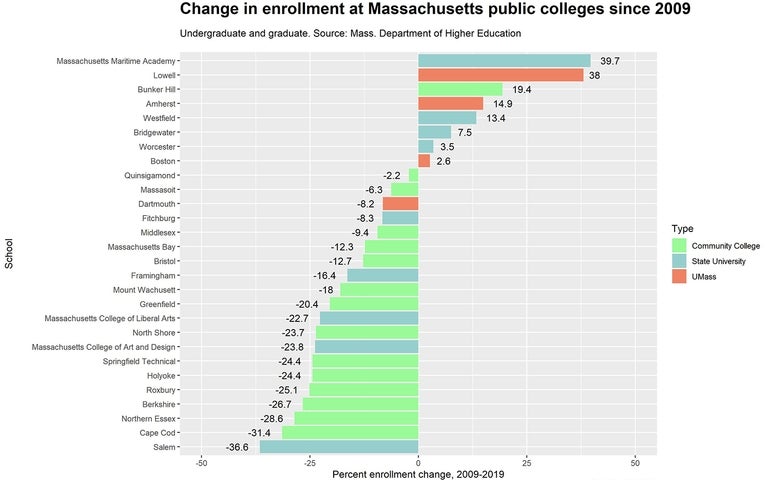Beacon Hill leaders reiterated a single statistic several times over the course of debate on a bill requiring greater financial transparency from the higher education world: over the past five years, 18 private colleges and universities in Massachusetts have closed or merged.
But those schools were not alone in facing challenges. Many of the key pressures that pushed them under — fewer available students and more competition to enroll them — present similar challenges to the University of Massachusetts, state university and community college systems.
Over the past decade, 18 of the state’s 28 public colleges and universities have experienced a decline in undergraduate student enrollment, half of which have seen drops of at least 20 percent. The change is more pronounced when combining undergraduate and graduate students, where 20 campuses now have smaller student bodies.
Schools have responded by tightening belts and cutting costs by combining back-end work such as IT and human resources. Many have shifted to greater use of adjuncts instead of full-time faculty. Northern Essex Community College closed 11 different academic programs over a single year.
But shutting down campuses, the most dramatic option that has prompted legislative action and pushed families to ask questions about stability they had never before raised, remains an unlikely outcome in the public sector, higher education officials say.
“I never say never because you don’t know what the circumstances might be,” Higher Education Commissioner Carlos Santiago said in an interview. “But I say, ‘look, quite honestly, we think we can get the institutions to work together to keep costs down so students can keep attending.'”
Small-scale consolidation on a voluntary basis, he said, has “worked so far.”
Across the country, college enrollment has been in a steady decline for about eight years at both private and public institutions, according to annual Census estimates.
Experts say the trend largely mirrors macro-level demographic changes: fewer students are enrolling because there are simply fewer young people to enroll.
The U.S. population is aging, with older adults forming a larger and larger portion. On the other end of the scale, thanks to a combination of factors including parents more frequently delaying the age at which they have their first child and economic stressors during the Great Recession, the birth rate continues to drop, hitting a 32-year low in 2018.
As a result, the number of current and future traditionally college-aged youth is shrinking.
The trends vary by region and by ethnicity, but they have been sharpest in the Northeast. Since 2011, the population 25 and older in Massachusetts has growth at similar annual rates to the rest of the country, but the youngest age cohort has seen more pronounced declines.

